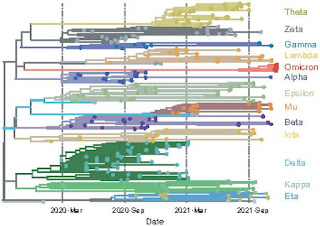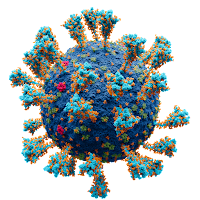The Omicron variant of SARS-CoV-2 contains a large number of novel mutations in the spike protein. How did these mutations occur and what is their effect on the properties of the variant?
The origin of the novel mutations
The phylogeny of the Omicron variant is unusual—it seems to have appeared without any documented history of steady accumulation of mutations. It looks like it split from the other variants before the summer of 2020. This leads to suggestions that the virus was circulating (and mutating) long before it was first detected.
One idea is that the ancestor of the Omicron variant jumped to another species and evolved in that species for 18 months before jumping back into humans. This would account for the lack of intermediates seen in screening infected patients. Several of the key mutations in the spike protein sequence are similar to variants that have adapted to bind to the mouse version of the receptor (ACE2) (Sun et al. 2021) and the Omicron spike protein binds strongly to mouse ACE2. (The original SAR-CoV-2 variants do not infect mice.) I think it's safe to conclude (tentatively) that Omicron evolved in mice and jumped back to humans in October or November 2021.
Immune evasion
The Omicron variant infects people who have been fully vaccinated or who have been previously infected with one of the other variants (Zhang et al. 2021). This is because the low level of circulating antibodies in these individuals is not sufficient to block Omicron. The level can be boosted with a booster shot (or a recent infection) and this increase protects against infections by Omicron. Fortunately, Omicron is attacked by T-cells and memory B-cells in vaccinated individuals so the infections are mild (Redd et al. 2021).
The mRNA vaccines elicit polyclonal antibodies to the spike protein of the original (Wu) variant. Some of these antibodies will recognize surface antigens that have mutated in Omicron so that's why it requires a higher concentration of antibodies to neutralize Omicron. We're lucky that boosting the overall antibody levels with a booster shot is sufficient to protect us from infection. We're also lucky that the T-cell response is robust—it didn't have to be.
The important point to remember during the Omicron wave is that the virus infects, and is transmitted by, fully vaccinated individuals (no booster). Some of the talking heads on TV seem to forget this when they advocate for keeping the schools open as long as everybody is vaccinated. That's not going to stop the spread and, besides, some of those vaccinated children are going to end up in the hospital. What they need to be telling us is that keeping schools open is going to result in X number of hospitalizations and Y number of deaths and this is an acceptable trade-off. (Parents, teachers, school bus drivers, school administrative staff, and their elderly parents may disagree.)
Transmissibility
The Omicron variant is highly transmissible, meaning that it is more infectious than the other variants. This feature explains the enormous spikes of cases in all countries that are experiencing an Omicron wave. We've not seen anything like that in previous waves.
Some of that peak might be due to the fact that vaccinated individuals are not being as careful as they should be so they are spreading the virus in their communities. That may explain the differences between different countries, or different states within a country, but it's not the full story.
Initially, there was a lot of speculation that the spike protein mutations in Omicron made it bind more strongly to the human ACE2 receptors and that would explain why the virus was more infectious. But most of those studies were based on models and the results from different groups were contradictory. Recently the Chinese scientists who have been at the leading edge of these studies since the beginning have shown that the Omicron spike protein does not bind significantly more tightly to ACE2 than the version from other variants (Zhang et al. 2021).
It looks like the increase in infectivity is due to enhanced entry of the Omicron variant into cells once it has bound to the receptor. Some of this is probably due to a mutation that creates a more favorable furin cleavage site but additional increases in entry might be due to conformational changes in the spike protein (Zhang et al. 2021)
Milder cases?
There's a lot of speculation that the Omicron variant causes less severe forms of COVID-19 but the data is complicated by the fact that vaccinated and convalescent patients are also suffering from COVID-19 and they are partially protected. I don't think it's really known whether naive (unvaccinated and not previously infected) individuals have a milder form of the disease and I know we don't have any data on the long-term effect of Omicron infection. Please let me know of any studies that have been released.
I don't know of any logical connection between the known mutations in Omicron and the severity of COVID-19.
Redd, A. D., Nardin, A., Kared, H., Bloch, E. M., Abel, B., Pekosz, A., Laeyendecker, O., Fehlings, M., Quinn, T. C., and Tobian, A.A. (2021) Minimal cross-over between mutations associated with Omicron variant of SARS-CoV-2 and CD8+ T cell epitopes identified in COVID-19 convalescent individuals. bioRxiv : the preprint server for biology, 2021.12.06.471446. [doi: 10.1101/2021.12.06.471446]
Sun, Y., Lin, W., Dong, W., and Xu, J. (2021) Origin and evolutionary analysis of the SARS-CoV-2 Omicron variant. Journal of Biosafety and Biosecurity. [doi: 10.1016/j.jobb.2021.12.001]
Wei, C., Shan, K. J., Wang, W., Zhang, S., Huan, Q., and Qian, W. (2021) Evidence for a mouse origin of the SARS-CoV-2 Omicron variant. Journal of Genetics and Genomics. [doi: 10.1016/j.jgg.2021.12.003]
Zhang, X., Wu, S., Wu, B. et al. (2021) SARS-CoV-2 Omicron strain exhibits potent capabilities for immune evasion and viral entrance. Sig Transduct Target Ther 6:430. [doi: 10.1038/s41392-021-00852-5]































